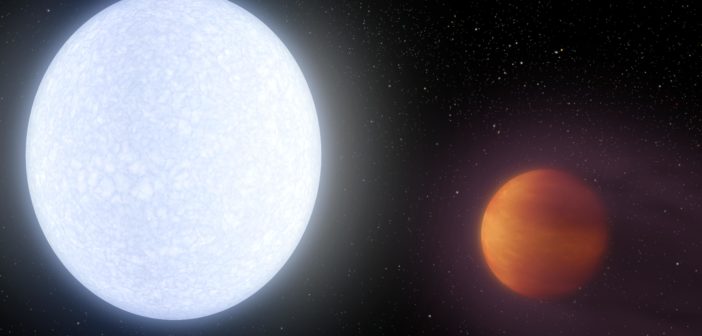Move over, hot Jupiters — there’s an even stranger kind of giant planet in the universe! Ultra-hot Jupiters are so strongly irradiated that the molecules in their atmospheres split apart. What does this mean for heat transport on these planets?
Atmospheres of Exotic Planets

A diagram showing the orbit of an ultra-hot Jupiter and the longitudes at which dissociation and recombination occur. [Bell & Cowan 2018]
Because of the intense stellar irradiation, there is also an extreme temperature difference between the day and night sides of these planets — potentially more than 1,000 K! As the stellar irradiation increases, the dayside atmosphere becomes hotter and hotter and the temperature difference between the day and night sides increases.
When hot atomic hydrogen is transported into cooler regions (by winds, for instance), it recombines to form H2 molecules and heats the gas, effectively transporting heat from one location to another. This is similar to how the condensation of water redistributes heat in Earth’s atmosphere — but what effect does this phenomenon have on the atmospheres of ultra-hot Jupiters?

Maps of atmospheric temperature of molecular hydrogen dissociation fraction for three wind speeds. Click to enlarge. [Bell & Cowan 2018]
Modeling Heat Redistribution
Taylor Bell and Nicolas Cowan (McGill University) used an energy-balance model to estimate the effects of H2 dissociation and recombination on heat transport in ultra-hot Jupiter atmospheres. In particular, they explored the redistribution of heat and how it affects the resultant phase curve — the curve that describes the combination of reflected and thermally emitted light from the planet, observed as a function of its phase angle.
For reasonable eastward wind speeds, Bell and Cowan found that the recombination of atomic hydrogen shifts the peak of the phase curve in the eastward direction, with the shift becoming more pronounced with increasing eastward wind speed. Additionally, because heat is distributed more evenly across the planet, including this process decreases the amplitude of the phase variations.
A Bright Future for Ultra-hot Jupiters

Theoretical phase curves for three wind speeds. Transits and eclipses have been neglected. [Bell & Cowan 2018]
Only a few ultra-hot Jupiters are currently known, but that will soon change. The Transiting Exoplanet Survey Satellite (TESS) mission, which is set to begin its first science observations on June 17, 2018, will search for exoplanets around bright stars, including nearby cool stars and more distant hot stars. The hot stars may play host to these exotic exoplanets, and upcoming observations of ultra-hot Jupiters like KELT-9b will put this theory of heat redistribution to the test.
Citation
Taylor J. Bell & Nicolas B. Cowan 2018 ApJL 857 L20. doi:10.3847/2041-8213/aabcc8
